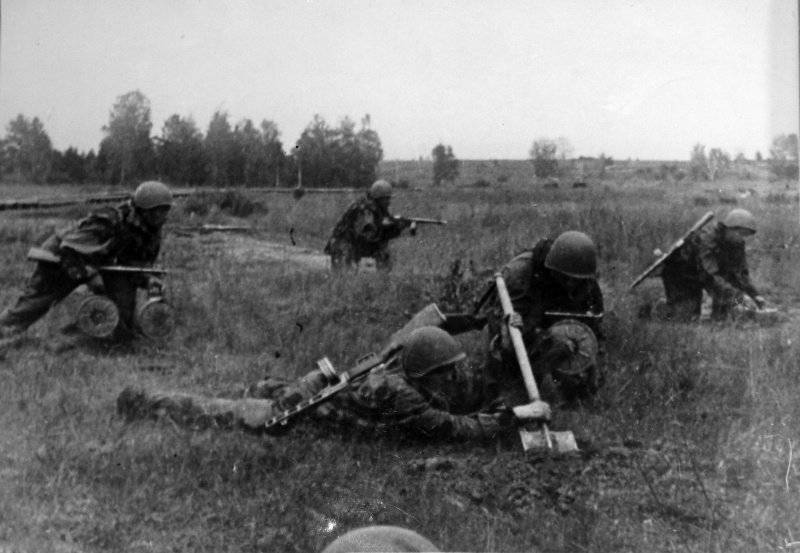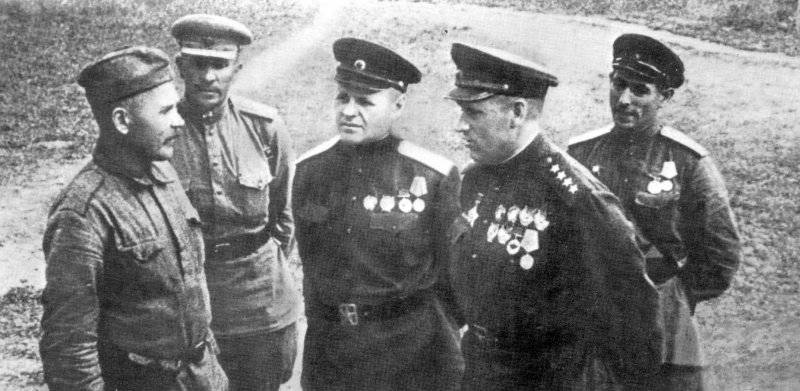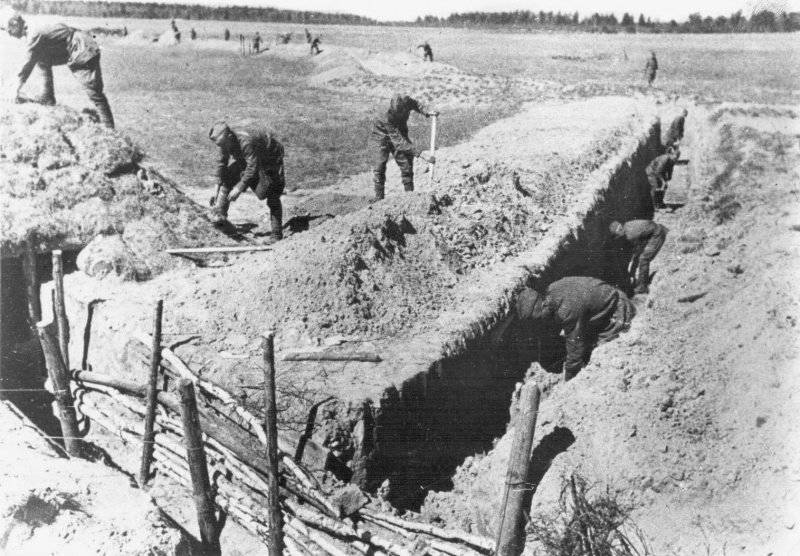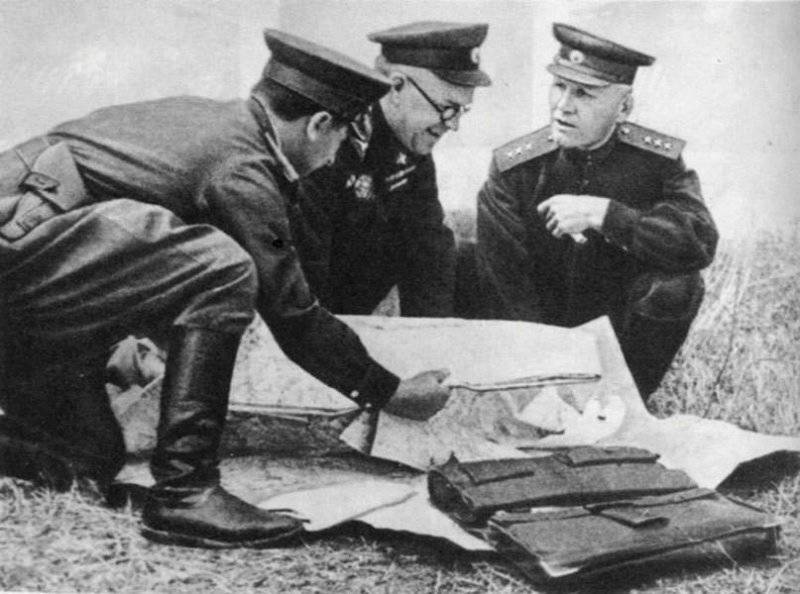The Great Battle of Kursk: Plans and Forces of the Parties. Part of 2
After the end of the winter campaign at the end of March 1943, the Soviet command began to develop a plan for the upcoming actions for the summer campaign. The Supreme Command Headquarters, the General Staff and all the front commanders who defended the Kursk salient participated in the development of the operation. The Supreme High Command was going to launch a large-scale offensive in the summer-autumn period, launching the main attack in the southwestern direction in order to defeat Army Group South, to liberate Left-bank Ukraine, the Donbass from the invaders, and force the Dnieper River.
Before the Headquarters, there was a difficult choice - to strike a warning strike or to defend. Each strategy had its own advantages and disadvantages. Despite the conviction of the German command that the Red Army would immediately go on the offensive after the end of the spring thaw period, the Soviet high command was in no hurry this time. On April 8, 1943, Headquarters representative Georgy Konstantinovich Zhukov, who was sent to the southwestern direction to stabilize the situation after the Kharkov defeat, sent the Supreme Commander-in-Chief his views on possible enemy actions in the spring and summer of 1943. Zhukov, given the high losses of the Wehrmacht in the winter campaign, believed that the German command did not have large reserves for a serious operation, such as an attack on Stalingrad and the Caucasus in 1942. The Marshal assumed that the Germans, having collected the maximum forces, including 13-15 tank divisions, with the support of significant air force forces, will strike with the Oryol grouping bypassing Kursk from the northeast and the Belgorod-Kharkov grouping bypassing Kursk from the southeast. The German command could deliver an auxiliary blow from the west from the Vorozhba area, between the Seim and Psel rivers, to Kursk from the southwest. Thus, Zhukov quite accurately defined the general plan of the German command.
Marshal Zhukov considered the transition of the Soviet troops to the offensive in order to pre-empt the enemy inappropriate. In his opinion, it would be better to wear down the enemy in a defensive battle, knock out his strike potential, tanks, and then, bringing fresh reserves into battle, go on a general offensive and defeat the main German grouping. That waiting will be delayed for the rest of the spring and part of the summer, George Zhukov did not anticipate.
Stalin, having received the report of Zhukov, instructed the General Staff to solicit the views of the front commanders and to prepare a special meeting on the summer campaign of 1943. April 12 held a special meeting at the Supreme Command Headquarters. It was attended by Stalin, Deputy Supreme Commander Zhukov, the head of the General Staff Vasilevsky and his deputy Antonov. The meeting made a preliminary decision on intentional defense, focusing mainly on the Kursk Bulge. After repelling the enemy strike, they planned to launch a counterattack and a general offensive, striking the main blow in the direction of Kharkov, Poltava and Kiev. In the absence of an enemy offensive for a long time, the transition of the Soviet troops to the offensive without prior defense was envisaged.
G.K. Zhukov and I.S.Konev on the Kursk Bulge.
It should be noted that the Soviet intelligence was able in advance to reveal the training of the German armed forces for a major attack on the Kursk salient and even set a date for the start of the operation. This information was obtained in the spring of 1943. April 12 on the table of the Supreme Commander, the exact text of directive No. 6 “On the plan of Operation Citadel of the German High Command” was translated from German. The document was not yet signed by Adolf Hitler. This valuable information was obtained and transferred to Moscow by an intelligence officer who worked under the name "Werther". His real name is still unknown. It is believed that he was an employee of the High Command of the German Armed Forces and the data he received were transferred to the Soviet Union through Lucius agent Rudolf Roessler, who was active on the Swiss territory.
Soon the data transmitted by Werther was confirmed from another source. The 7 of May of the T-bills received a message from the London station, it contained the text of a telegram intercepted by British intelligence from 25 in April by Field Marshal Maximillian von Weichs to the operational department of the High Command headquarters. This document was handed over to the Soviet intelligence officer Kim Philby by one of the members of the Cambridge Five, John Cairncross. The Briton worked in the service of decryption. Cairncross has been a Soviet intelligence agent since 1935. The telegram intercepted and deciphered by British intelligence set out in detail the plan of Operation Citadel. At the end of May 1943, the General Staff received a special report from the 1 Directorate of the NKGB USSR, which indicated strikes by German groups along the Kurs-Belgorod-Maloarkhangelsk line.
On the evening of May 8, the Headquarters warned the fronts of a possible enemy strike. The fronts command was informed of the possibility of a German offensive on May 10-12 on the Oryol-Kursk or Belgorod-Oboyan directions, or both. By the morning of May 10, the Supreme High Command ordered the troops of both the first line of defense and the reserves to be fully operational. Aviation should not only protect the troops from the attacks of the enemy air force, but also gain air supremacy. In May, the German offensive did not follow, the commander of the 9th Army Model persuaded Hitler not to start the operation.
In principle, in May the Red Army itself could go on the offensive. The compounds were replenished with people and equipment, could begin active operations, relying on the already created powerful defense system. However, the idea of “deliberate defense” was already predominant. In addition to the defensive positions of armies and fronts, which were to meet the blow of the German groups, a developed system of rear lines and strategic reserves were created, which allowed the enemy to withstand the blow, even if the Germans broke through the defenses of the armies of the Central and Voronezh fronts. At the same time, offensive operations (the future Rumyantsev and Kutuzov) were being prepared.
Waiting for the enemy to strike was psychologically heavy, but it gave more time to prepare defensive lines. In addition, intelligence data did not give an answer to the question of where the main attack would be delivered and the exact location of the offensive of the enemy troops. There was no complete information about the number of troops involved by the German command. The headquarters and the General Staff believed that the enemy would strike the main blow from the Orel area on the Central Front. In reality, the Belgorod group of the Wehrmacht will be the strongest, which will strike the Voronezh front. Therefore, despite the fact that Zhukov and Vasilevsky (the head of the General Staff) adhered to the idea of moving to defense in the area of the Kursk salient, there were also opponents of such a strategy. The Red Army had everything necessary for an offensive, and the commanders of the Voronezh and Southern fronts, Generals Nikolai Vatutin and Rodion Malinovsky, insisted on delivering a preemptive strike in the Donbass region. They were supported by the members of the Supreme Headquarters Semyon Timoshenko, Clement Voroshilov and some other military leaders. The final decision of the Soviet command was adopted in late May - early June 1943 of the year. Most researchers believe that the decision on intentional defense, in this case was the most rational type of strategy.
The defensive operation in the area of Kyrsky ledge involved mainly forces of the Central and Voronezh fronts. To support them, the Reserve Front was formed by 30 on April, then it was renamed the Steppe Military District, and from July 9 1943 of the year - under the Steppe Front commanded by Ivan Stepanovich Konev. The 27 th, 47 th, 53 th army and 5 th air army were initially included in the Steppe Front. The troops of the Steppe Military District were located in reserve behind the Central and Voronezh fronts. The steppe front was supposed to stop the advance of the enemy troops in case of its breakthrough. On July 18, the 69 Army and the 7 Guards Army were included in the Steppe Front, and in September the 4 and 5 Guards armies, 37 and 46 armies.
The Reserve Headquarters of the Supreme Command and in the second echelon of the fronts were deployed 5 tank armies, several separate tank and mechanized corps, a significant number of rifle corps and divisions. From April to July, the Central and Voronezh Front was reinforced by 10 rifle divisions, 10 anti-recourse software, anti-tank artillery brigades, 13 separate anti-tank artillery regiments, 14 artillery regiments, 8 shelves and their own stope-and-go-off-on-put-off-and-go-to-off-order artillery. Two fronts that were supposed to repel the blow of the enemy were given over 7 thousand guns and mortars, 9 aircraft.
Representatives of the Supreme Command Headquarters Marshals of the Soviet Union Georgy Zhukov and Alexander Vasilevsky coordinated the actions of the fronts in this direction, the artillery was supervised by Colonel-General Artillery Nikolai Voronov, and the aviation marshal Alexander Novikov.
By the beginning of the Great Kursk battle, the Central, Voronezh fronts and the Steppe fronts had more than 1,9 million people (of which 0,6 million was in reserve), more than 26,5 thousand guns and mortars (with 7,4 thousand in reserve), over 4,9 thousand tanks and self-propelled guns (1,5 thousand in reserve), about 2,6 thousand aircraft (of which 0,5 thousand were located in reserve).
After solving the tasks of a strategic defensive operation, the Soviet command planned to launch a counteroffensive. The implementation of the Kutuzov plan - the defeat of the Oryol German grouping was entrusted to the troops of the left flank of the Western Front under the command of Colonel General Vasily Sokolovsky, the Bryansk Front under the command of Colonel General Markian Popov and the right flank of the Central Front Konstantin Rokossovsky. The implementation of the Rumyantsev plan was an offensive operation on the Belgorod-Kharkov direction, planned to be carried out by the formations of the Voronezh Front under the command of Nikolai Vatutin, the Steppe Front Ivan Konev and the forces of the South-Western Front Rodion Malinovsky.
The forces of the Central, Voronezh Fronts and the Steppe Fronts created a powerful defensive system, which included 8 defensive lines and lines with a total depth of 250 – 300 km. Great attention was paid to anti-tank, anti-artillery and anti-aircraft defense with deep echeloning of battle formations. A developed system of strong points, dugouts, firing points, trenches, communication lines and anti-tank and anti-personnel barriers was created. On the left bank of the Don they created a state line of defense. The depth of the defense lines on the Central Front, where the German troops were waiting for the main attack, was 190 km, on the Voronezh Front - 130 km. Each front was equipped with three army and three front lines of defense. Rokossovsky's central front was composed of: 48, 13, 70, 65, 60 and 2 tank armies. The Voronezh Vatutin Front also had six armies: the 6, the 7, the Guards, the 38, the 40, the 69, and the 1. The command of the Central Front located in the first line all five combined-arms armies, the 2-I tank army was in the second echelon and two tank corps (9 and 19) were in reserve. On the Voronezh front in the first echelon there was an 4 army. The width of the defense lines of the Central Front was 306 km, and the Voronezh one - 244 km.
The Soviet command paid great attention to the formation of artillery groups. 10 on April 1943, the People’s Commissariat of Defense issued a special order on the use of artillery of the High Command Reserve (RVGK), reinforcement of artillery regiments of reinforcement for the armies and the formation of anti-tank and mortar brigades for the fronts. In the defense lines of the 48, 13 and 70 armies of the Central Fleet, on the intended direction of the main attack of the German Oryol grouping was concentrated, together with the second echelon and front reserves, to 70% of all guns and mortars of the front and 85% of the entire artillery of the High Command. . In the defense zone of the 13 Army, where the point of impact of the 9 Army was aimed, they concentrated 44% of the RVGK artillery regiments. The 13 Army was attached to the 4 th Artillery Breakthrough Corps, which had 700 guns and mortars and 432 rocket artillery. On the Voronezh front in the front line, where the 6-th and 7-th Guards armies were located, concentrated up to 66% artillery of the Supreme Command-87 from 130 artillery regiments. The command paid great attention to the mines of defensive lines. The average mining density in the direction of the expected strikes of the German groups was 1,5 thousand anti-tank and 1,7 thousand anti-personnel mines for each kilometer of the front. The troops of the Central Front during April-June 1943 of the year installed up to 400 thousands of mines. and land mines.

Soviet sappers set up TM-42 anti-track mines in front of the front edge of the defense. Kursk Arc, Central Front.
By the time the Battle of Kursk began, the Soviet command had established closer cooperation with partisan units than it had been before. In preparation for the battle on the Kursk bulge, the central headquarters of the partisan movement organized mass sabotage in the rear of the German Army Groups Center and South. Particularly important were the strikes of the partisans on enemy communications. By the summer of 1943, the Belarusian partisans forged their actions with more than 80 thousand German soldiers and officers, Smolensk partisans - up to 60 thousand, Bryansk - about 50 thousand Nazis.
It should be noted and dedicated work of the civilian population. The population of the Kursk, Oryol, Voronezh and Kharkiv regions, with the mobilizing role of the party and Soviet organs, provided tremendous assistance to the troops of the fronts. The inhabitants of the front-line areas helped the Soviet soldiers to build defensive lines, repair roads, repair communications destroyed by German aviation.
The Central Front. Rokossovsky, on the basis of an assessment of the situation, believed that the enemy would launch an offensive against the forces of the right wing of the front, delivering the main attack on Ponyri, Olkhovatka, Zolotukhino, Kursk in the 13 Army’s defense zone, and auxiliary attacks from Zmiivka to Droskovo and from Trosny to Kursk . Therefore, the front command decided to reduce the 13 Army’s defense line from 56 to 32 kilometers and increase its strength to 4 corps - 12 rifle divisions. The construction of the army has become a two-echelon. The commander of the 13 Army was Lieutenant-General Nikolai Pukhov.
In addition to the 13 Army Pukhov, on the way of the German strike, there were units of the 48 Army as part of the 7 rifle divisions. The 48 Army I, Lieutenant General Prokofy Romanenko, occupied an area of 38 km to the right of the 13 Army. On the left of the 13 Army, the forces of the right wing of the 70 Army Lieutenant General Ivan Galanin were deployed as part of the 5 rifle divisions. Thus, 95 rifle divisions from the 24 division and 41 brigades, which the TF had, were deployed in the 4-kilometer sector of the front, where the enemy was expected to advance. Ten rifle divisions were deployed in the main defense zone, nine divisions in the second defensive zone, and five divisions of the 13 Army were located in the area of the army defensive zone. The rest of the front with a length of over 200 km defended 17 rifle divisions and 4 brigades. It was the left-flank corps of the 70 Army - 3 rifle divisions; 65 Army Lt. Gen. Pavel Batov - 9 rifle divisions and one brigade; 60 Army Lt. Gen. Ivan Chernyakhovsky - 5 rifle divisions and brigade 3. The total number of ZF to 1 July 1943, the year was 711,5 thousand people, 5359 guns, 5792 mortar, 1897 tanks and self-propelled artillery installations. Most of the tanks and self-propelled guns were subordinated to the front as part of the 2 tank army under the command of Alexey Rodin, 9 and 19 tank corps. Part of the tank units was subordinated to the armies.

The commander of the Central Front, Army General K.K. Rokossovsky and a member of the Military Council of the Front, Major General KF Telegin at the forefront of the battle of Kursk.
Voronezh Front. It was more difficult for General Nikolai Vatutin, commander of the Voronezh Front, to determine the direction of the main strike of the German Belgorod group. Komfronta considered it possible to attack the enemy troops in three directions: 1) from the area west of Belgorod on Oboyan; 2) from Belgorod to Korocha; 3) from the area west of Volchansk to Novy Oskol. The first two areas were considered the most likely. Therefore, the command of the VF concentrated its main forces in the center and on the left flank of the front, on a stretch of 164 kilometers, which amounted to two thirds of the total length of the front. In all three directions, counter-attacks were prepared by second echelons with reserves involving the forces of the first echelon.
Four armies were in the first echelon of the defense: 40-I, 38-I combined and 6-I and 7-I guards. In the center and on the left wing of the front there were three armies as part of 7 rifle divisions each. 40-I Army Kirill Moskalenko defended a sector of the front in 50 km, 6-I Guards Army Ivan Chistyakov was responsible for the sector in 64 km, 7-I Guards Army Mikhail Shumilov - 50 km. In the first echelon of the front 21 division was deployed: 12 rifle divisions (4 in each army) occupied the main line of defense, 8 divisions - the second line, one division was located in the army defense zone behind the left wing of the 40 army. On the right flank of the Voronezh Front, against the right flank of the 2 of the German army, in the 80 km zone, the 38 Army was under the command of Nikandr Chibisov as part of the 6 rifle divisions (five divisions were in the first echelon of defense, one in the second).
In the second echelon of the defense of the Voronezh front, the defense was occupied by the 1-I tank army of Mikhail Katukov (31-th, 6-th tank corps and 3-th mechanized corps), it closed the direction of Oboyan - Kursk; and Vasily Kryuchyonkin's 69 Army (5 rifle divisions, they were deployed in the 6-th and 7-th Army Guards Armies) defended Belgorod, Korocha and Volchanks, New Oskol. The reserve VF 35-th Guards Rifle Corps (consisting of three rifle divisions), who stood on the left flank of the first defensive line, as well as 5-th and 2-th Guards tank corps.
The uncertain situation with the direction of the main attack of the German troops and the error with the place of the main attack (he was waited in the Central Front) was aggravated by the features of the defense line of the Central and Voronezh Fronts. On the northern face of the Kursk Bulge, the terrain was less favorable for the movement of large masses of armored vehicles (the terrain was more wooded). At the FC, this area band was about a third of the entire plot, while for the VF it was two thirds. Vatutin was forced to smudge the troops on a wider front, reducing the density of military formations in the place where the German command would deliver the main attack. In particular, the 40 Army of Moskalenko, which was away from the direction of the strike of the 4 Panzer Army of Goth, was more powerful than the 6 and 7 Guards armies, which took the enemy's attack. The 40 Army had more anti-tank 45-mm guns, 76,2-mm regimental guns, 82-mm and 120-mm mortars, than the 6-I Guards Army. At the same time, the 40-i army defended the 50-Kyometrovy sector of the front, and the 6-I Guards-64-kilometer. The 40 Army was also the leader in the number of tanks among the armies of the Voronezh Front — 237 vehicles (in the 6 Guards — 135 tanks). Already in the course of the battle, the units of the 40 Army began to be transferred to the aid of the Guards, but the 6 of the Guards Army was no longer relieved. Yes, and the German troops were easier to beat the Soviet troops in parts. The total number of troops on the Voronezh Front at the beginning of July was 1943, 625,5 thousand people, 4155 guns, 4596 mortars and 1701 tanks and self-propelled artillery.
It is clear that in such a situation, “deliberate defense” was unacceptable for Vatutin’s com-front. With an unfavorable development of the situation, the Voronezh Front could come to a catastrophe. Therefore, Nikolai Fedorovich would prefer to attack. Vatutin repeatedly asked the General Staff the question of the need to launch an offensive in the south-western direction. In addition, he expressed fears that the enemy would never advance and the Soviet troops would miss the time to conduct offensive operations in the 1943 year. Vatutin convinced Vasilevsky: “Let's stop digging and start first. We have enough strength for this. ” According to Vasilyevsky, the Supreme Commander was also unstable. Vatutin insisted that he should strike no later than the beginning of July. Stalin considered that this proposal deserved attention and ordered the commander to prepare his ideas on this matter and report them to the Headquarters. The long delay in the German offensive made Stalin worry and think about a preemptive strike.
On 2 on the night of July 2 on July 1943, the directive of Supreme Command Rate No. 30144 was sent to the commanders of the Western, Bryansk, Central, Voronezh, Southwestern and Southern fronts, where it was noted that German troops could launch an offensive during July 3-6 . The troops were ordered to be fully prepared to repel the blow and to strengthen the observation of the Germans.

Construction of fortifications on the Kursk Bulge.
- Alexander Samsonov
- The Great Battle of Kursk: Plans and Forces of the Parties
The Great Battle of Kursk: Plans and Forces of the Parties. Part of 2
The Great Battle of Kursk: a defensive operation of the troops of the Central Front
The Great Battle of Kursk: a defensive operation of the troops of the Central Front. Part of 2
The Great Battle of Kursk: a defensive operation of the troops of the Central Front. Part of 3
Great Battle of Kursk: defensive operation of the troops of the Voronezh Front
The Great Battle of Kursk: a defensive operation by the troops of the Voronezh Front. Part of 2
The Great Battle of Kursk: a defensive operation by the troops of the Voronezh Front. Part of 3
The Great Battle of Kursk: a defensive operation by the troops of the Voronezh Front. Part of 4
The Great Battle of Kursk: Operation Kutuzov
The Great Battle of Kursk: Operation Kutuzov. Part of 2

Information